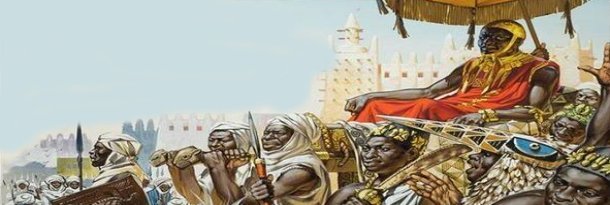|
Ancient Mali Empire |
Ancient Mali Empire |
Ancient Mali Empire | Ancient Mali Empire |
For information, videos and photos of the West African country of Mali, check out our Mali pages.
More >
|
|

|
Sundiata did not just conquer; he organised. He established a new capital at Niani and implemented a system of government that respected local traditions while ensuring central control. This new capital at Niani became an important financial and trading centre, not least because it was located near the Bure goldfields, a significant resource that led to the incredible wealth of the nascent Mali empire that would later allow his successors, like Mansa Musa, to project its power and splendour across the globe. The empire was born not from a slow evolution, but from a calculated and decisive rebellion against a crumbling old order. In 1255 Mansa Uli (above), Sundiata Keita's only biological son, succeeded his father after the emperor reportedly drowned in the Sankarani River. Uli I, a highly ambitious prince expanded the empire further to the east and set about increasing agricultural production. When he died in 1270 he left no heirs, resulting in a power struggle between his adopted brothers Mansa Ouati (Wati) Keita and Mansa Khalifa Keita with Wati becoming Mansa, forcing his brother into exile.
The reign of Abubakari I (1275 - 1285) saw the restoration of Mali's fortune's after the mismanagement of his nephews. He was succeeded by former slave and army general Mansa Sakura who seized the throne in 1285 and reinforced the Mali empire's military position including the conquest of Gao. However he was assassinated in 1350 and succeeded by Sundiata Keita's sister's son, Gao. Gao ruled until 1305 when he was succeeded by his son Mohammed ibn Gao who himself ruled for a further five years before being succeeded by his uncle Abubakari II (above) in 1310. Abubakari II himself abdicated in favour of exploration and there were unsubstantiated reports that he had actually discovered the New World. By this time the Mali rulers had converted to Islam and Abubakari II's successor following his abdication, Musa I, was a devout Muslim, who made an historic pilgrimage to Mecca in 1324, promoting Mali along the way as a prosperous, educated and awe inspiring empire.
The reign of Musa is widely regarded as being ancient Mali's most powerful period. He was succeeded by his son Maghan (1337 - 1341) who, in turn, was succeeded by his uncle and father's brother Suleyman who ruled until 1360. However these and subsequent kings were widely regarded as weak and unable to maintain the integrity of the empire. Over these and subsequent years, the ancient Mali Empire became fragmented and, after the death of Mahmud IV in 1610, there was no clear ruler with his three sons fighting over his legacy. The Empire of Mali was effectively over. There followed a long period of various groups running the area which changed in shape and size over the centuries until Mali came under French colonial rule in 1892 as part of the Scramble for Africa. The area, then known as French Sudan, became the autonomous state of the Sudanese Republic in 1958 and gained full independence from France in 1960, forming, together with Senegal, the Federation of Mali. However months later Senegal withdrew from the federation and the Sudanese Republic was renamed the Republic of Mali. |
 For Sundiata Keita (right) had overcome his physical infirmities and grown into a charismatic and formidable leader. He returned from exile, rallying the discontented Mandinka chiefs and other ethnic groups who had suffered under Soso oppression, and offered them a new vision: a united kingdom where they would no longer be subjects, but masters of their own destiny.
For Sundiata Keita (right) had overcome his physical infirmities and grown into a charismatic and formidable leader. He returned from exile, rallying the discontented Mandinka chiefs and other ethnic groups who had suffered under Soso oppression, and offered them a new vision: a united kingdom where they would no longer be subjects, but masters of their own destiny.




 Wati ruled (badly) for just four years before being succeeded by this adopted brother, a former freed slave, Khalifa Keita. In turned out that Khalifa was to be an even worse leader, reportedly spending time shooting passers by with arrows for sport. It was an ugly precedent as he ended up being assassinated and succeeded by his uncle and Sundjata Keita's brother, Abubakari I, who had previously been appointed to serve as regent until Uli was old enough to serve as Mansa, but was usurped by Uli claiming the throne early.
Wati ruled (badly) for just four years before being succeeded by this adopted brother, a former freed slave, Khalifa Keita. In turned out that Khalifa was to be an even worse leader, reportedly spending time shooting passers by with arrows for sport. It was an ugly precedent as he ended up being assassinated and succeeded by his uncle and Sundjata Keita's brother, Abubakari I, who had previously been appointed to serve as regent until Uli was old enough to serve as Mansa, but was usurped by Uli claiming the throne early. On his return Musa started a building program, constructing mosques and universities across his fiefdom. By this time ancient Mali was the source of half the world's gold and its territory had expanded north and west to the Atlantic ocean and, by the fourteenth century, was about the size of Western Europe, being the envy of many other African nations.
On his return Musa started a building program, constructing mosques and universities across his fiefdom. By this time ancient Mali was the source of half the world's gold and its territory had expanded north and west to the Atlantic ocean and, by the fourteenth century, was about the size of Western Europe, being the envy of many other African nations.


